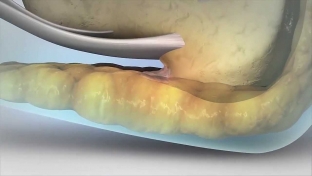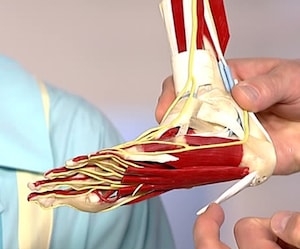Severe pain and discomfort is caused by the appearance of a heel spur, which develops as a result of plantar fasciitis (an inflammatory process of the fascia). The heel is especially sore in the morning or after a sitting position, when the leg is resting and there is no tension. Such a disease causes a lot of trouble, because the patient begins to limp in order not to feel pain, the spine begins to bend, sometimes the pain is so great that it is almost impossible to walk. With the vivid symptoms of a heel spur, you can even cope on your own, medical assistance will be needed for effective treatment and elimination of the spur with medication. Treatments for heel spurs can be used at home, gymnastics is especially effective, both for treatment and for prevention.
What are the causes of heel pain
The heel can hurt due to plantar fasciitis, and the spur appears as a result of the chronic course of the disease. Plantar fascia provokes pain – it is a connective tissue that connects the heel bone and phalanges of the toes, while strengthening the longitudinal arch of the foot. When a person walks, especially if the shoes are uncomfortable or with high heels, then an inflammatory process begins at the site of attachment of the fascia to the heel bone as a result of the appearance of soft tissue tears. An outgrowth begins to form near the heel bone and a so-called spur appears, which injures neighboring tissues, which causes acute pain. The fact is that the heel spur itself may not hurt, several factors are needed that contribute to the onset of pain and inflammation:
- excess weight increases the load on the foot several times, especially on the heel;
- diabetes mellitus;
- flat feet result in too much tension on the fascia;
- arthritis or Bechterew's disease (connective tissue disorders);
- age-related changes lead to a decrease in the fat pad to protect the calcaneus, which begins to be injured when walking;
- pathologies of the spine, joints;
- impaired circulation in the legs and arms;
- the presence of diseases of the joints, blood vessels;
- injuries, fractures, ligament damage;
- uncomfortable shoes increase the level of stress on the foot, heel;
- work related to the legs: in a sitting position or need to be constantly on the move.
Symptoms of a heel spur
This disease immediately makes itself felt, there is pain in the heel area – this is the main symptom. The pain may be barely noticeable, intensify with the first steps after rest. The patient begins to limp, so as not to cause another attack of pain. The condition may worsen in the evening, when the heel has worked hard during the day. Another symptom that speaks of a spur is reddening of the heel, the skin becomes rough and hard. If you do not seek help in time and do not determine the means of treating heel spurs, then the skin & nbsp; can fester, infection of soft tissues begins. Even during rest, during palpation, a person feels pain and tension.

Diagnosis and treatment of heel spurs
At the appointment with the surgeon, it will immediately become clear that pain in the heel begins due to the presence of a spur. The doctor will also recommend an x-ray of the leg and an ultrasound to carefully examine the site of inflammation and the size of the spur. Treatments for heel spurs are recommended to be taken in stages, in order to first unload the heel and try not to step on it, and only then you can apply ointments. The main treatments for heel spurs are:
- Therapeutic exercise.
- Relieving the load from the foot in several ways: roller, horseshoe, taping.
- Using night cuts.
- Shock wave therapy.
- Blocks for pain relief.
To remove the initial pain, it is worth resorting to bed rest and moderate exercise to relieve severe tension from the heel. When walking, you can fit a roller under the base of the heel so as not to come into contact with the floor, or make a horseshoe with your own hands and attach it to slippers, make a recess in the spur area. Thus, the spur will not injure nearby tissues. You can use taping – fixation of the ligaments and muscles of the leg with adhesive tape or a special tape. At night, put the foot in a cut in the form of a boot to fix the position of the leg, which helps to heal the cracks in the fascia.
 Shock wave therapy is an effective treatment for heel spurs. With the help of such therapy, salt growths on the bones are destroyed. A minimum of 5 treatments of 20 minutes is required to completely remove the spur from the heel.
Shock wave therapy is an effective treatment for heel spurs. With the help of such therapy, salt growths on the bones are destroyed. A minimum of 5 treatments of 20 minutes is required to completely remove the spur from the heel.
Also exercise therapy is indicated to stretch the plantar fascia. You can do the following exercises:
- Take the necessary position: legs one after the other (like standing on a rope), hands lean against the wall. Squat until you feel tension, do not tear off your heels. Freeze for a minute and return to the original position.
- Equip a platform of books, for example, 5 cm high. You can also do it on steps. Stand on a step or stack of books with your heel hanging down. Next, bend towards the wall so that the calf muscles are stretched. Freeze for a minute and return to the original position.
- Scatter small items on the floor about 30 pieces of different sizes, it can be balls, coins, beads, pebbles, keys. Try to pick them up with your toes. Thus, the muscles of the foot are trained.








Add a comment